During the Middle Ages a system of woodland management grew up. I must say that it did not apply in forest. Forest is a legal term that nowadays denotes a wooded area, but in Mediaeval times it denoted an area where hunting rights were reserved by the king, and there are areas of forest today that are not remotely wooded and never were in recorded history. In the forest deer were allowed to run wild and so the thin shoots of coppiced tree would soon be eaten by them. Forest was at best woodland pasture disrupted by deer hunts.
Foresters became adept at the art of coppicing, and they worked according to a cycle for different trees.Hazel was cut every eight years, ash every fifteen and oak every twenty five. Beech could also be cut, but it is a tree that does not coppice well and so was not cut on a regular cycle. But before the poles were cut they were trained by being tied to prevent them from growing crooked and so being useless for tool handles. So they would be originally tied at the bottom to determine direction and successively new ties would be added so that the poles would be straight.
Willow coppice was also common in the British Isles, and if you have ever heard the Irish song Down by the Sally Gardens, the word sally gardens refers to the fact that some Irish villages used to have willow gardens to provide wood, which were regularly coppiced. Willow would grow well on the edges of the bogs that are common in parts of Ireland. Sally comes from the Latin name for willow, Salix.
Coppicing was performed in Spring. There as an art to the timing. Too early, while it was still cold, the young shoots would not have time to harden off before they faced frost; too late the sap in the tree was rising and the tree would suffer a wound that could damage its future health. Any, dormant shoots were better to work than shoots with sap in them.
Foresters would cut the poles and sell them on to turners, who would use traditional lathes to smooth the wooden poles into handles for tools. If you know anyone called Turner their ancestors were woodland craftsmen who often used coppiced wood to make tool handles.
There seem to have been advantages to having your woods coppiced, for the process encouraged biodiversity. The reason for this is that certain trees have a habit of dominating British woodlands. Oak is king, but beech can be quite aggressive in its growth. But as beech does not coppice well, cropping it for coppice allowed space in woodlands for other kinds of tree to grow, such as the small-leaved lime, which is a native British tree which has been struggling for habitat over the centuries. Coppicing also created glades that allowed the light that enabled wildflowers to flourish.


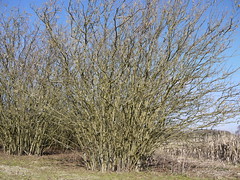





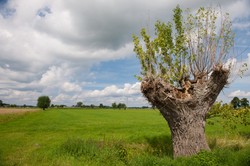

 TheThousand Year Gardenon 11/26/2025
TheThousand Year Gardenon 11/26/2025
 Women of the Gospelson 10/11/2025
Women of the Gospelson 10/11/2025
 Religious Gardenson 08/25/2025
Religious Gardenson 08/25/2025
 Doctor of the Church: John Henry Newmanon 08/03/2025
Doctor of the Church: John Henry Newmanon 08/03/2025

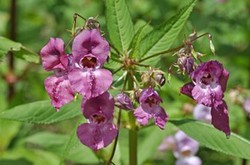
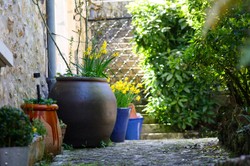
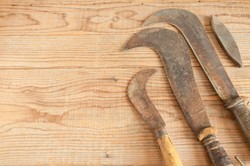
Comments
Thank you for your comment below, in answer to my previous observation and question.
Your comment three boxes down, on Dec. 20, 2023, in answer to my previous, previous-day observation and comment Dec. 19, 2023, considered that "The stumps are cut to about three inches,but the shoots will be left to grow until they reach the desired length."
Is there a standard "desired length"?
There is no limit to the stems that can bud from a healthy tree. The gap sycamore is now sprouting shoots. Wonderful.
Thank you for your comment below, on Dec. 20, 2023, in answer to my previous, previous-day observation and question Dec. 19, 2023.
Is there a desired number of shoots to inhabit the stump surface or is it whatever is there is fine as long as it is healthy?
The stumps are cut to about three inches,but the shoots will be left to grow until they reach
the desired length. If the tree is cut much higher than the stump it is called a pollard.
Your introduction informs us that coppiceable trees must be cut down to the stump and left to grow many poles.
Is there a standard height at which one must cut the stump down to?
Those who coppice here might cut their stumps down to just 2 to 3 inches (50.8 to 76.2 millimeters) above ground level.
When dealing with the Neolithic we cannot be exact. The nearest few hundred years is The best that we can do.
The discovery of neolithic coppicing sounds so intriguing.
Would the discoverers have come up with a timeline for the accomplishment?
The surname may be short for Forrester, one who worked in the royal forests.it is a surname derived from an ancestor's job.
The first paragraph under your second subheading, Woodland Management, describes a forest as "in Mediaeval times" denoting "an area where hunting rights were reserved by the king, and there are areas of forest today that are not remotely wooded and never were in recorded history."
Does the surname Forest have nothing to do with privileged status or does it result as a last name given to or taken by people assuring those hunting rights or otherwise assisting the monarch?
(Nature-related names interest me as an arborist and as an Ibero-Americanist. African and European Jews historically looked to Portugal as fundamentally not at all anti-Semitic. Even up through the time of Calouste Gulbenkian [March 23, 1869-July 20, 1955], they opted for names such as Floresta ["forest"] when they permanentized their residence there.)
Thank you for commenting, friendly comments are always welcome, as are new readers and writers.